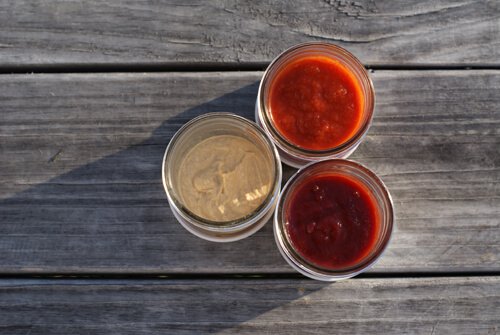Cooking for a Family When One Person Has a Food Sensitivity

Over the years, we’ve had our fair share of special diets.
Each of our children has dealt with strong food sensitivities and restrictions at one point or another. Sometimes we make changes to our diet as a family, requiring everyone to eat the same thing.
Other times, that’s not so practical. When our 2 year old daughter began going through a series of special diets last year to try to clear up her pervasive eczema, the rest of us (2 adults and 2 older children) didn’t want to adhere to her particular diet if we didn’t need to.
At 2 years old, she was the smallest eater of out of the five of us. That fact made me hesitant to spend the extra time and money that it would require for everyone to eat a menu that met her unique needs (no wheat, no dairy, no rice, no tomatoes, no citrus, no peanuts, etc.).
Isn’t it more work to make different food for different people?
It might sound as though it would be easier to prepare the same thing for everyone, and it’s certainly my preference to cook just one meal.
That said, I still need to make meals that pleased my husband’s palate, appealed to my older kids (and yes, to myself), and I knew that her dietary needs required particular (often more expensive) ingredients, in addition to more cooking and preparation time on my part.
I opted to cook as usual for the family, while finding ways to make simple adaptations that would render our meals Johanna-friendly or have alternative foods to satisfy her. The name of the game became keeping my daughter well-fed while avoiding kitchen mutiny from the masses. A challenge? Perhaps, but it’s not as hard as it sounds.
Here are 6 ways that I worked around my daughter’s needs while feeding my family:
1. Find meals that work for everyone.
It helps to make yourself a list of what foods are fair game for all… for us, this included potatoes and sweet potatoes or yams, corn, eggs, kamut or spelt, coconut milk, most nuts and seeds, all meat and fish, beans, most veggies and fruits. When I looked at what she could eat, instead of what she couldn’t, I realized a number of meals would fit the bill.
- Chicken (or fish or meat of some sort) with roasted potatoes and vegetables
- Shepherd’s Pie (if I kept the mashed potatoes dairy free)
- Eggs, breakfast meat and fruit, at breakfast
- Fish cakes and yam fries (if I used an alternative flour in the fish cakes)
- Pancakes, made with kamut flour, or grain-free ones we all enjoy (with eggs, peanut butter and bananas)
As much as possible, adapting your recipes and finding things that work for the entire family just makes sense.
2. Find meals that almost work for everyone, where you can tweak small things.
After #1, this is the most common way that I accomodate her needs. Good examples of this include:
- Oatmeal (she uses coconut or almond milk, while we use raw cow’s milk)
- Taco salad (she skips the cheese and sour cream, and gets extra guacamole and meat)
- Sandwiches (I buy or make bread just for her, so all the fillings are the same, but she uses her bread and skips the cheese)
3. Find meals where the bulk of the meal is the same, but one component is different.
Pasta is a prime example. It’s common for me to prepare a pasta sauce for everyone, and then boil up two pots of pasta– brown rice pasta for us, buckwheat (soba) noodles for her. The sauce is the part that requires the most effort, so making two types of pasta added very little extra work.

4. Remember that kids aren’t as picky as adults and may be satisfied with simple solutions.
If it’s a child that has the allergy or special dietary needs in your family, it’s helpful to keep in mind that their culinary tastes are less refined than ours may be. If I eat pasta, I want a hearty sauce, like tomatoes with plenty of meat and vegetables, savory herbs and spices. Johanna, however, enjoys noodles with just veggies, simple seasonings and maybe some canned fish or chunks of chicken.
Yogurt was another tricky issue that had a surprisingly simple solution. I was trying to figure out a yogurt alternative that she could have for the times when we ate granola (which I adapted to her needs). Even the coconut yogurt at the store has rice starch as an ingredient, and goat’s dairy is out for her as well. But she was content to have granola with extra fruit and some “milk” poured over it, no yogurt texture required. Personally, I don’t enjoy granola with just plain milk, but she was 100% happy with it.
5. Keep special treats around.
Having yummy snacks and treat foods for the one with the special diet is so important. They need to know that they are just as valuable as every other member of the family, and that they haven’t been forgotten or bypassed when the celebration foods come out.
Things that have worked well for us: some type of bar (either the SunRype Fruit & Veggie bars or Larabar fruit and nut bars– storebought or homemade), coconut milk ice cream or popsicles in the freezer, a handful of dates (her favorite), frozen bananas that can be whipped up into a quick smoothie or “ice cream” at a moment’s notice, some dark (dairy-free) chocolate store up high in the cupboard, “cheese” crackers.
6. Figure out quick work-around solutions.
We love smoothies, but I didn’t want to make everyone’s smoothie dairy and citrus free (we love yogurt or raw milk and sometimes a bit of orange juice in our smoothies). Realizing I would always need to make 2 different smoothies, I came up with two strategies to simplify the process:
- Simpler recipes to make for my daughter (just coconut milk, bananas, blueberries and green powder, for example) before making the larger one with slightly more complex ingredients for the rest of us.
- Making her small smoothie first, so that I didn’t need to wash out the blender before making ours (if I did it the other way around, I would have to rinse to avoid her smoothie being contaminated by our yogurt).
This is just an example, but small things like this add up to less time in the kitchen. Other solutions for me have included baking extra loaves of bread for her at one time and storing them as half-loaves in the freezer, just the right size to go through for one little person. Are there any currently tedious tasks that you could simplify somehow?





Love this as we’ve also been through this off and on (mostly on) for the last few years. The biggest key for me is having QUICK meals on hand that can accommodate all our needs. We’ll fail any “diet” if I don’t have an out for those hard hard days (or even just the days I forget to start the roast chicken early!)
We most definitely deal with different dietary needs in our house, and I appreciate this post! Our 4-year-old cannot have egg or wheat/rye/barley (gluten) or dairy (although we are slowly phasing that back in after a year without it). Our 21 month old cannot have dairy.
Our 4 year old is pretty easy–believe it or not. Once I figured out how to bake without eggs and use GF subs, it hasn’t been too hard. She understands very clearly that she cannot have those foods or her tummy will hurt. She was 3 when we found out, and she was already very verbal, so it wasn’t hard to explain.
Our 21 month old is a different story. She wants a bite of EVERYTHING the rest of us are eating! I love dairy, so I have to hide my cheese, yogurt, etc. or she will be wanting some! Even the smallest bite seems to tear up her stomach.
I usually try to cook the same meals for dinner–but I will just leave off what the girls can’t eat from their plates (harder still with my younger one).
Thanks for the ideas! 🙂
Isn’t it wonderful when they grasp onto the foods that they can’t have and they understand why they can’t have it? Our 3 year old is getting to that place, and she’s so cute– she’ll frequently remind me of the things that she can’t have, and double check that I’m not giving her something like cow’s dairy. I love it. 🙂 But, we have also dealt with a food stealing issue for the past year as well, as she has struggled to want to eat food that she sees. I think she’s finally understanding better and that makes it easier, so hopefully it will get better with your 21 mth old, too.
These are great ideas! Both of our kids have food allergies (one more than the other), and it was definitely a steep learning curve when it came to balancing money, time, and nutrition when it came to their diet needs vs. our tastes. We’ve finally settled into a good groove, and thankfully, have been able to incorporate some foods back into our diet. I still struggle with dairy-free yogurt, too, as the homemade coconut milk yogurt is very tricky! Half the time, the batch is ruined for one reason or another; it’s not nearly as easy as cow’s milk yogurt. Anyway, other than that, we have really managed a nice balance between his diet and ours and accommodating everyone’s tastes.
You’re brave to try homemade coconut yogurt. I was just buying it for awhile, until we realized she was also sensitive to the rice starch in it. But you know what actually works quite well? Coconut milk kefir, made thickly or strained, in place of yogurt. I found that pretty foolproof, and I would be making it myself right now if I hadn’t killed my kefir grains (oops). 🙂
My 22-month-old is allergic to eggs and peanuts, and intolerant of something in dairy but not sure yet if protein or lactose, and just this past week we discovered he can no longer eat cinnamon! It’s not too much of a big deal – my husband and I just add cheese to our own plates if a dish requires (tacos, pasta, etc) and I have found not using eggs in baking isn’t too big of a deal! However this has limited us in my son’s breakfasts – I pack it every day for daycare and I have resorted to Van’s frozen waffles as they are gluten, dairy and egg free, and thankfully some flavors don’t have cinnamon.
Hi Helen! Your 22-month-old’s allergies are almost exact to my 3 year-old. That is very odd because I thought she was so rare! Cinnamon makes her mouth swell and hives to break out around her lips. It seems to be such an odd reaction! She is growing out of the dairy allergy, though; she can tolerate lactose-free milk and the occasional tiny bit of regular cheese and yogurt is no problem. Eggs are also no problem as long as they are baked in something. And (PTL!) she isn’t allergic to peanuts; we survive on PB&J in this house. Good luck to you and your little one!
My question is how do I cook for a family when the father has sensitivities to dairy, eggs, oats, kidney beans (and other beans). One daughter must do GAPS. One has something affecting her that causes Asthma, but I can’t peg it. One other one gets eczema from Oats. And I don’t do well with wheat or sugar even in small amounts?
Working around this many things makes cooking a nightmare. I usually sacrifice myself, and deal with the fall out. Or, I make everyone stick to GAPS, and add a side of starch… but breakfast is the worst meal of the day. My husband needs protein and grains, I need protein and fat, my kids need protein and fat, but my husband can’t eat eggs. UGH….
I try not to think about it too hard… lol… still trying to figure it out over here. Ultimately I’d rather that everyone did GAPS for two whole years without cheats, and then we probably wouldn’t have HALF the sensitivities we have now.
Oh, that’s so hard. I can only imagine. I think you’re wise to consider putting everyone on GAPS, but of course, it’s hard when it includes our husbands. They need to be totally on board to want to do it for themselves. I have heard of some moms doing GAPS for everyone, and then simply doing as you do sometimes, adding a side of grains/starch for the husband at certain meals (by keeping bread/buns in the freezer, making/reheating pots of rice, that sort of thing).
Awesome advice!
3/4 of the folks in our house have to be dairy-free and I don’t eat meat so our meals tend to go the same way. This is awesome and simple advice to follow!
I made myself a list of things that our family could eat with these same easy “rules” so that I could easily refer to it on our fridge when meal planning or preparing snacks for the kids. Here is the printable that I use: https://cube2farm.wordpress.com/2012/02/20/dairy-free-meal-planning-printable/ in case there are any other dairy-free readers out there who could use it!
Thank you for your insightful and helpful post!
My two daughters have different allergies. One corn and one wheat. They both can’t do dairy. My husband is dairy free and can’t handle certain meats. We pretty much follow the rules you have up there. In order to keep costs down around our house and less time in the kitchen, though, I will cook up big batches of “safe” meat and big batches of sauces (mostly red sauce and enchilada sauce). Once I figured out how to do this and implement, my kitchen time decreased by at least fifteen minutes. Woohoo! Cause let’s face it, cooking for multiple food allergies takes time. But I wouldn’t have it any other way 🙂
This is SUPER helpful – thanks!!! Even as we try to wrestle through our two diets (for weight loss, not food sensitivities). I always think about food issues in the most complicated ways possible. :-/ This is really, really helpful!
I know, they can definitely FEEL really complicated and sometimes overwhelming. I am so glad this was helpful for you. 🙂
I am going to bookmark this and come back to it. I’ve done various diets, but none of them help to this point with me completely. Thankfully my kids seem fine at this point, and we don’t have to avoid anything further with them (other than I extremely limit sugar, not eating it at home, and rarely while out- my oldest can’t seem to tolerate it much at all). My baby seems sensitive to cow’s dairy, as I now occasionally can eat some dairy, but I rarely do. If I do, she gets a rash.
Its me thats the issue. I was fine with what I had done, but now I am having issues all over again. It may or may not be diet related. I think it has a lot to do with hormones, and a lot to do with stress. But because of the extreme stressful situations we are under at the moment, I don’t have any energy to figure it out right now. When things get slower again, I am going to try an elimination diet.
The one thing that scares me is getting enough calcium. I know that is highly controversial. I was drinking a lot of almond milk, but it still doesn’t have the best ingredients. I am not sure making it at home would have enough calcium. I don’t really know what to do. All of this takes so much time and energy and I just don’t have that so sometimes I make choices based on my limited ability to keep coping, if that makes sense. At least its just me with the sore stomach.
Are you eating bone broth, though? Because that’s such a great source of calcium, not to mention other minerals and gelatin. Another really good, non-dairy source is eating canned salmon, with the bones. I make sure my non-dairy daughter eats a lot of fish bones to keep her calcium intake up.
Yes I do eat bone broth, many times a week. We probably have it in recipes or in soup probably 4-6 times a week, or more.
Do you know how much calcium is in it, per cup?
We also do salmon, but all I can afford for fish is canned salmon, and I wonder about the BPA and also the mecury in salmon, so I try to limit that (we typically have it 2-3 times a month, max)…but maybe I shouldn’t limit it, I don’t know. Because we don’t live near fish places or the coast we don’t have good options for getting fish other than those canned Gold Seal or such brand cans on sale, or expensive fish that isn’t so fresh, or ones frozen that say “from China” and have preservatives.
As for the bone broth, I always make it the way you taught me through your blog, but I have never, ever had it gel for me except when I put water in the bottom of the slow cooker to cook my chicken first (from raw) then that water gels. But the regular broth I make from the bones, it doesn’t. I use cold water, I use my crock pot, I use apple cider vinegar. I read that sometimes people smash the bones with a hammer? I don’t know. Is it still beneficial calcium-wise and other wise if it doesn’t gel? I never know how much calcium is in it eg. how many mg. per cup because I know for example milk has 300 mg and nursing women are supposed to get 1200 mg for example.
I don’t know how much it in it per cup. I think it would be hard to calculate because it just really varies from batch to batch, but I would try googling it.
To get more gel, have you tried adding chicken feet? I get some when I do it like usual, more when I do as you said the cook the chicken in the crockpot first, and then the most when I add chicken feet. I actually found them at Superstore/Extra Foods (Loblaws to you, maybe?).
And I wouldn’t limit your canned salmon. If it’s one of the only things you eat from a can (it is for us), and it’s not tune (which is more likely to be high in mercury than salmon), then I think you should go for it. I’ve read studies that compared moms who ate lots of fish (from all different sources) compared with those who didn’t, and the risks of being exposed to the heavy metals, toxins, etc. was FAR outweighed by the benefits of eating lots of fish. Their children did far better on intelligence tests (among other things) both as babies and toddlers, and also years down the road. They could tangibly see the benefits of the fish, but couldn’t tell whether there were any obvious effects of the toxins from the fish. I’m tempted to think that with fish, as long as we avoid the really bad ones (like the varieties of tuna that receive warnings), I think the risk is worth the benefits.
thank you!!!
This is a very helpful article. My husband eats kosher, but not fr religious reasons. I simply dislike the taste and texture of mammals and shellfish. My husband is allergic to eggs and my 7 month old daughter reacts if I eat them.
I am strongly considering switching to a kosher diet (and kitchen) and eating vegan myself. This is based on health and weight-loss goals as well as my ethical concerns that I have. I am basically a failure as a Dairyland girl.
This article was very helpful!
A side note, I think it is important to remember that some children outgrow allergies & sensitivities. I used to be allergic to strawberries, thankfully not anymore. I hope my sweet babe isn’t allergic to corn like her aunt, that is another tough one.
Great ideas! I’m following Marcelle Pick’s 30-day eating program from her book The Core Balance Diet. The recipes are terrific! My husband and kids are usually fine with what I serve, but would like more of our “old” food. I’m going to try some of your suggestions and see if it helps me juggle.